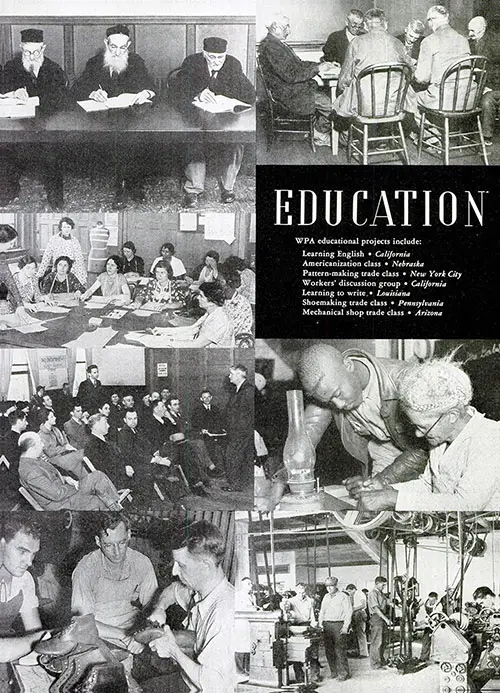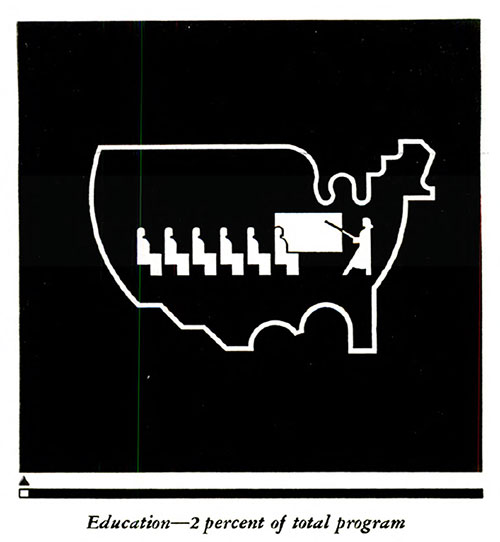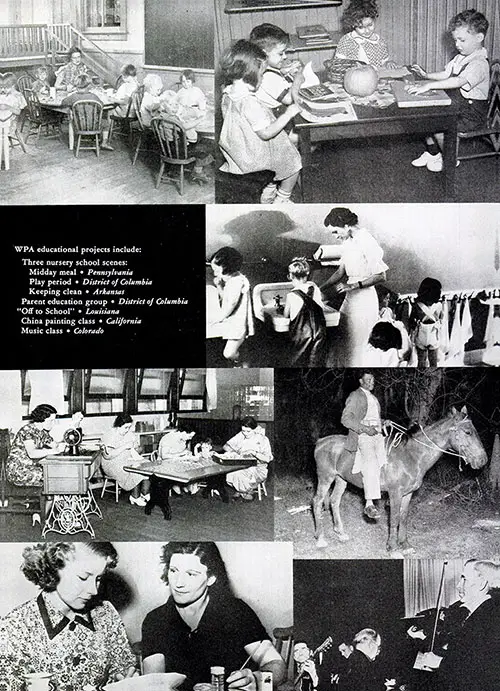WPA Educational Projects - 1938

WPA Educational Projects Include Learning English (California), Americanization Class (Nebraska), Pattern-Making Trade Class (New York City), Workers' Discussion Group (California), Learning to Write (Louisiana) Shoemaking Trade Class (Pennsylvania), Mechanical Shop Trade Class (Arizona). Inventory: An Appraisal of Results of the Works Progress Administration, Washington, DC: US Government Printing Office, 1938. GGA Image ID # 1520287141
The WPA Education program has given work in their own field of experience to tens of thousands of unemployed teachers, keeping them fit to return to non-relief jobs, and through these teachers has brought new educational opportunities to millions of citizens.

Education—2 Percent of Total Program. Inventory: An Appraisal of Results of the Works Progress Administration, Washington, DC: US Government Printing Office, 1938. GGA Image ID # 152040a29e
In March 1938, 34,097 persons were employed on WPA educational projects throughout the country, about 95 percent of whom had been taken from local relief rolls. Under these teachers were enrolled a total of 1,542,021 persons in adult education classes, and 44,190 young children in nursery schools. In addition, 903,912 persons were attending other meetings, such as forums and lectures.
Operating through the established State agencies of education, on the principle that education is a function of the States rather than the Federal Government, the program has placed its emphasis on adult education and upon nursery schools, not only because these fields are above and below the usual range of public school service, but also because they are fields in which the depression years had brought out urgent educational needs.
The 1930 census showed that 4.3 percent of all Americans 10 years old and over are illiterate. Other studies indicate that if those are added whose knowledge is so meager that it is useless for any practical purpose, 8 to 10 per- cent of our people are cut off from written communication or from information through the printed word.
Such people, on the whole, have the lowest earning power and so the least consuming power. Unnecessary sickness is prevalent among them. Their children are retarded in school because of the intellectual poverty of their homes and are usually the first to leave school.
They are dangerous to a democracy, in that they are easy prey to propaganda and exploitation, and in times of depression, many of them quickly become public charges. In this field, WPA classes have enabled more than 1,000,000 illiterate American men and women to master a practical knowledge of reading and writing.
Many of the more than 200,000 persons re- ported currently in literacy classes are also candidates for citizenship, and to these the WPA teachers are offering courses designed to provide an understanding of the responsibilities, principles, and ideals of democratic government.
In November 1937, the Commissioner of Immigration and Naturalization gave official recognition to these classes by directing examiners to give consideration to certificates of their completion. But bare literacy is only the beginning of education, and many other types of adult need are being met by WPA classes and forums.
Many men and women whose schooling was cut short early in life now want to continue their education. As a result, 353,503 persons are enrolled in 25,570 classes teaching a wide variety of general subjects. More than 300,000 others are taking cultural and creative courses in order to develop constructive leisure-time interests.
The WPA education program includes "workers' education" classes and public affairs forums, to foster and increase popular under- standing of today's economic, political, and social problems which affect the welfare of all citizens.
More than 95,000 persons attend the various "public affairs" classes, and 60,000 more attend forums or other meetings. For children of low-income families, from 2 to 5 years of age, the WPA operates 1,494 nursery schools, with an enrollment of 44,190 children. Each child is given a well-balanced service covering health and nutrition, play and social development.
More than 200,000 children have benefited from these services. Education also is given to parents of the children. Women who work on WPA projects and wives and mothers who must provide for families from meager budgets which must be stretched to the limit to cover the vital necessities—133,000 of them—are being taught about foods, clothing, nutrition, health, and household management.
More than 60,000 others attend classes in child behavior and development, and family relationships. Undoubtedly the greatest contribution of the WPA in occupational training is by means of actual work on projects. But the education program has provided teachers for the training of foremen, for instruction in safety and first-aid, and for a wide variety of training in occupational skills.
Moreover, more than 200,000 persons are enrolled in 12,303 classes which offer either brush-up courses for experienced workers, or more thorough training in the less technical vocational fields.
From the standpoint of the teachers themselves, the program has enabled thousands to return to permanent non-relief jobs, not only by improving their training and enlarging their experience, but also by demonstrating the need for extension of State and local educational services, thus creating more jobs.
Lester K. Ade, Pennsylvania's State Super- intendent of Public Instruction, finds that "the demonstrated values of the service have been recognized by many public school officials, who have taken over the program as an integral part of the functions of the public schools."
Floyd I. McMurray, Indiana State Superintendent of Public Instruction, finds the pro- gram has created "a general demand that the work be permanently continued as a part of our State education." "In my judgment," says Director George D. Stoddard of the Iowa Child Welfare Research Station, "a historical perspective far removed from emergency needs will assign to the WPA well-earned credit for advancing the frontiers of American education."
Mark Starr, educational director of the Inter- national Ladies' Garment Workers' Union, adds: "The WPA education program has encouraged participation by labor unions in the study of labor problems and, in my judgment, has made a notable contribution to the elimination of social illiteracy."

WPA Educational Projects Include Three Nursery School Scenes: Midday Meal (Pennsylvania), Play Period (District of Columbia), Keeping Clean (Arkansas), Parent Education Group (District of Columbia), "Off to School" (Louisiana), China Painting Class (California), Music Class (Colorado). Inventory: An Appraisal of Results of the Works Progress Administration, Washington, DC: US Government Printing Office, 1938. GGA Image ID # 1520406761
"Education," in Inventory: An Appraisal of Results of the Works Progress Administration, Washington, DC: US Government Printing Office, 1938, pp. 37-40.

